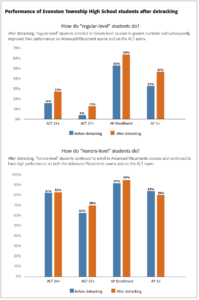 A diverse high school detracks its freshman courses and sees impressive gains down the road in terms of AP attendance and achievement scores.
A diverse high school detracks its freshman courses and sees impressive gains down the road in terms of AP attendance and achievement scores.
In 2010, Evanston Township High School dramatically changed its freshman year for incoming students. The school detracked freshman English, history, and biology courses for the vast majority of students — and, by doing so, removed barriers for historically under-represented student groups and provided greater access and opportunity to all.
The school’s rationale? Students who have access to and succeed in the most rigorous courses have opportunities to attend college and earn more during their careers than those without similar access or success.
The fact is, income gaps are widening, and gaps in academic achievement persist. Across the United States, gaps of between 25 and 30 points in reading and mathematics between whites and blacks and between whites and Hispanics have been consistent from 1992 to 2013 (Kena et al., 2014). These gaps contribute to opportunity gaps — and Evanston Township decided to do something about it.
The change was met with controversy in the community and in the media. The Chicago Tribune editorial board (2010) characterized our freshman restructuring as “Honors? Horrors!” claiming that restructuring would not have a positive effect on student achievement and would actually hurt college prospects for top students.
That was six years ago. Today, the school is thriving. Student access to and success in honors and Advanced Placement (AP) courses are at all-time highs. We’ve received national attention in both the National Journal (Quinton, 2015) and PBS NewsHour (Friedman, 2015). In addition, we hosted a sold-out American Educational Research Association site visit.
The impetus for change
Evanston Township High School, located just north of Chicago, enrolls 2,300 students and is 30% black, 16% Hispanic, 43% white, and 41% low income. Throughout its 132-year history, the school has wrestled with the achievement gap. Although Evanston was a founding member of the Minority Student Achievement Network — a national coalition of multiracial, suburban-urban school districts that came together in 1999 to eliminate achievement and opportunity gaps — incoming freshmen were rigidly tracked. They were assigned to honors, mixed-honors, mixed-regular, and regular tracks based on a single standardized test score from 8th grade. The designation of “honors” didn’t even take into consideration how students actually performed in class. This approach resulted in a structural barrier to mobility, which all but excluded students in regular tracks from accessing the most rigorous curriculum throughout their high school careers.
Access to AP courses was constrained through a rigid set of prerequisites and teacher recommendations. As a result, although the percentage of successful AP students was high, participation and diversity were low (Bavis, Arey, & Leibforth, 2015).
Before the restructuring, there was also great variability in the curriculum. Inconsistency of expectations, assessments, and semester exams resulted in a student experience that largely depended on the student’s placement and teacher.
In 2010, the board of education adopted an equity and excellence statement to guide the district’s work: “Embracing its diversity, Evanston Township High School dedicates itself to educating all students to their fullest potential.” Central to this statement is the dual focus on raising achievement for all students. Concurrently, the board approved restructuring freshman English, history, and biology courses.
Superintendent Eric Witherspoon clarified the benefits of restructuring, noting that it:
- Creates a stronger learning environment;
- Ensures that high achievers are challenged at the highest level and held to the highest academic standards;
- Ensures that far more 9th graders take challenging classes;
- Creates pathways for many more students to take honors and AP classes; and
- Raises expectations for all students.
The earned honors credit model
Teams of English, history, and biology teachers developed the detracked courses. In each subject, teachers identified the skills students would need in junior and senior AP courses and how teachers might develop those skills in freshman year. Restructured courses focused on increasing students’ ability to reason, analyze, collaborate, write, and synthesize, and they emphasized deep understanding of content.
High expectations came in the form of the earned honors credit model. In this system, students work toward earning honors credit by participating in a series of assessments that use common rubrics aligned to AP skills and expectations. Honors is determined by the quality of student work. All students in the courses participate in these rubric-driven assessments. Students who earn honors credit in these courses are able to demonstrate the depth and breadth of their skills by successfully completing a series of assessments.
For example, one of the earned honors assessments in English is a literary analysis essay. Student essays are scored using a rubric that assesses focus, content, organization, style, and mechanics. This rubric is shared with students early in the semester, and students receive feedback on their work.
Social psychologist and educator Claude Steele (2010) has found that feedback grounded in high standards, as in the rubrics used in the freshman restructured classes, reduces stereotype threat in students of color. In stereotype threat, students feel at risk of conforming to usually negative stereotypes about their social or racial group. Feedback works when students of color see it as a means to meet a high standard delivered by teachers who believe students can achieve that standard. Central to the feedback students receive in freshman restructuring is the message that they can meet the high standards in the rubrics. This enables students to focus on meeting high standards instead of doubting their intellectual abilities.
Freshman restructuring also put the focus on the work students do in the class as opposed to their placement in a class. Students work toward earning honors credit throughout the semester. They’re becoming honors students rather than just being labeled honors students before the start of the course. In this way, restructuring embraces what Stanford researcher Carol Dweck (2006) calls a growth mindset.
A look at AP and honors courses
Listening to students of color talk about their academic experiences was also important. Many spoke about the challenge of being the only student of color in their AP or honors class. Central to the school’s approach was increasing the critical mass of diverse students in AP and honors courses — critical mass being the point at which there are enough students of a subgroup to ameliorate stereotype threat. Steele points to critical mass as a key strategy to improve the trust, comfort, and achievement of students of color. Having more students of color in AP classes signals that students of color belong in that space.
A primary goal of freshman restructuring was for more students to have access to and be successful in honors and AP courses as they progress through 11th and 12th grade. This goal was supported by an emerging consensus in the scholarly literature that even attempting an AP class increases a student’s academic trajectory (Bowen, Chingos, & McPherson, 2009; Jackson, 2010; Keng & Dodd, 2007). Researchers have found that students who earned an AP exam score of 2 (5 is the highest score) had better college performance and higher four-year graduation rates than students who didn’t take an AP course (Hargrove, Godin, & Dodd, 2007).
The idea isn’t new. More than 15 years ago, a U.S. Department of Education study found that:
. . . the impact of a high school curriculum of high academic intensity and quality on degree completion is far more pronounced — and positively — for African-American and Latino students than any other precollege indicator of academic resources. The impact for African-American and Latino students is also much greater than it is for white students (Adelman, 1999).
It works!
We’re now five years into the freshman restructuring. Our first group of students to take earned honors English and history graduated in 2015. That group posted the highest average ACT score (23.9) in school history (a score of 20 is the national ACT average), took the most AP courses in school history, and earned the highest number of college-ready scores of 3 or more on AP exams. More important, each subgroup posted the best results they’ve ever seen on each of these measures.For our 2016 graduating cohort, across all historic placement groups, there was an increase in the percentage of students enrolling in at least one AP course in 11th grade. The greatest increase — 113% — involved students who would normally have placed into a regular-level course freshman year. Put another way, 91 students who would have been placed into regular-level courses in 9th grade took AP courses in 11th grade.
 When asked about what’s different now in her freshman humanities course, English teacher Julie Mallory started by pointing out what’s the same: “I still have a classroom full of 14-year-olds with a variety of skill sets and learning styles — all classrooms do, no matter how we label them, as AP, honors, or regular.” What’s different, she explained, is that she’s much more aware of the effect of those labels and of the assumptions they carry. “There’s a tendency to assume a certain level of student proficiency based on the label a course carries,” she said. “Removing the stigma of a label has enabled students to focus on the learning that needs to happen, instead of assuming a role the institution has awarded them based on a standardized test they took in middle school.”
When asked about what’s different now in her freshman humanities course, English teacher Julie Mallory started by pointing out what’s the same: “I still have a classroom full of 14-year-olds with a variety of skill sets and learning styles — all classrooms do, no matter how we label them, as AP, honors, or regular.” What’s different, she explained, is that she’s much more aware of the effect of those labels and of the assumptions they carry. “There’s a tendency to assume a certain level of student proficiency based on the label a course carries,” she said. “Removing the stigma of a label has enabled students to focus on the learning that needs to happen, instead of assuming a role the institution has awarded them based on a standardized test they took in middle school.”
As a result, Mallory’s teaching is more focused. She’s intentional about sending a message to students that all students can master these skills, that learning requires effort, and that she doesn’t expect them to get things right the first time they try. She’s found this message is particularly effective with traditional honors-level students, who often believe they should already know everything and who may be reluctant to try new things for fear of failure.
Is it working? Yes. Noted Mallory, “More students achieving at higher levels is the trend in all my classes. These trends aren’t just highly rewarding; they also validate the hard work of teaching.”
Evanston Township has partnered with Northwestern University to form a technical advisory group to evaluate the long-term outcomes of freshman restructuring. This group is looking at a variety of academic outcomes: the increase in enrollment in honors and AP courses, the increase in academic achievement as measured by course grades, the increase in ACT scores, the increase in AP scores, the increase in graduation rates, and the increase in college acceptance and retention rates.
 The importance of noncognitive factors
The importance of noncognitive factors
Rigor is not enough to get such good results. Noncognitive factors also shape students’ school performance (Dweck, 2006; Farrington et al., 2012). These include behaviors, skills, and attitudes that are essential to academic achievement but are not necessarily reflected in test scores. For example, students who possess a sense of belonging, believe that effort pays off, and that academic work has personal value have stronger academic outcomes than their peers who do not possess these beliefs. The research suggests that interventions focused on changing students’ beliefs about their intelligence and on other psychological factors can have transformative effects on their school experience and their grades. In particular, interventions designed to change academic mindsets have been shown to have significant effects on the achievement of racial and ethnic minority students (Aronson, Cohen, & McColskey, 2009).
Belief systems relating to motivation, effort, and locus of control — that is, how strongly students believe they have control over their lives — are interrelated; together, they can influence academic behavior. If students believe ability is fixed, they’re less likely to be self-motivated and persistent compared with students who believe that their own efforts can increase their academic ability and performance. If students believe they can be successful in school, they’re more likely to put forth continued effort (Farrington et al., 2012).
As part of the restructured freshman year evaluation, Evanston surveyed students in freshman restructured classes to monitor their effort and locus of control. Students who score high on this measure exhibit an internal locus of control; they believe they have command over their learning. Students who score low exhibit an external locus of control; they believe that external factors have command over their learning. With the restructuring, we found that most students reported putting forth effort in these courses. We also found racial differences: White students reported having a higher locus of control than black or Hispanic students. Just being aware of this information informs classroom instruction. Future work includes looking at 11th-grade survey results on locus of control. We’re also partnering with researchers from Northwestern University to explore this topic and possible interventions.
The importance of supports
With increased rigor comes the necessity of providing abundant supports. Our study centers are open before, during, and after school Monday through Friday. Teachers are on hand every morning before school starts to help students with any questions or concerns. Our homework center is open Monday through Thursday after school. We also offer academic support on select Saturdays throughout the year. In addition, an academic intervention team of trained professionals identifies and assists students who are struggling.
As a result of conversations with students about achievement, AP students created teamASAP — team Access and Success in Advanced Placement — to support fellow students to and through AP courses. The team empowers students with the tools they need and with a belief they can successfully navigate the most challenging coursework. For example, each fall, many students new to AP classes struggle to adjust to the workload. As part of the work, team-ASAP members confirm to new AP students that the first few weeks of an AP course are often the most difficult and that over the semester these courses get easier. Members also encourage those new to AP to form study groups to review challenging content. This affirmation of struggle and hope is an essential component of the peer-to-peer support teamASAP offers. The team includes more than 275 members from diverse backgrounds, from students who have taken or are taking AP courses to faculty and staff.
Our overarching purpose
With the overhaul of the freshman year, a far wider range of students now has access to and is experiencing success in advanced coursework. If we have any hope of reducing persistent achievement gaps and ever-widening income inequality, increasing students’ access to advanced courses and improving their chances of success in those classes are good places to start.
References
Adelman, C. (1999). Answers in the toolbox, academic intensity, attendance patterns, and bachelor’s degree attainment. Washington, DC: Economic Policy Institute.
Aronson, J., Cohen, G., & McColskey, W. (with Montrosse, B., Lewis, K., & Mooney, K.). (2009). Reducing stereotype threat in classrooms: A review of social-psychological intervention studies on improving the achievement of black students. Washington, DC: U.S. Department of Education, Institute of Education Sciences, National Center for Education Evaluation and Regional Assistance, and Regional Educational Laboratory Southeast. http://ies.ed.gov/ncee/edlabs/regions/southeast/pdf/REL_2009076.pdf
Bavis, P., Arey, B., & Leibforth, D. (2015). Advanced Placement: An open invitation. Educational Leadership, 72 (9), 36-40.
Bowen, W.G., Chingos, M.M., & McPherson, M.S. (2009). Crossing the finishing line: Completing college at America’s public universities. Princeton, NJ: Princeton University Press.
Chicago Tribune. (2010, December 17). Honors? Horrors! [Editorial]. Chicago Tribune.
Dweck, C.S. (2006). Mindset: The new psychology of success. New York, NY: Random House.
Farrington, C.A., Roderick, M., Allensworth, E., Nagaoka, J., Keyes, T.S., Johnson, D.W., & Beechum, N.O. (2012). Teaching adolescents to become learners: The role of noncognitive factors in shaping school performance: A critical literature review. Chicago, IL: University of Chicago, Chicago Consortium on Chicago School Research. https://ccsr.uchicago.edu/sites/default/files/publications/Noncognitive%20Report.pdf
Friedman, B. (2015, May 27). Illinois high school shrinks its achievement gap for minority students by setting a high bar. PBS NewsHour. www.pbs.org/newshour/bb/illinois-high-school-shrinks-achievement-gap-minority-students-setting-high-bar
Hargrove, L., Godin, D., & Dodd, B. (2007). College outcomes and the AP experience: Does the AP grade “2” matter? Paper presented at American Educational Research Association, April 2007, Chicago, Ill.
Jackson, C.K. (2010). A little now for a lot later: An evaluation of a Texas Advanced Placement incentive program. Journal of Human Resources, 45 (3), 591-639.
Kena, G., Aud, S., Johnson, F., Wang, X., Zhang, J., Rathbun, A., Wilkinson-Flicker, S., & Kristapovich, P. (2014). The Condition of Education 2014 (NCES 2014-083). Washington, DC: U.S. Department of Education, National Center for Education Statistics.
Keng, L. & Dodd, B. (2007). An investigation of college performance of AP and non-AP student groups. Paper presented at American Educational Research Association, April 2007, Chicago, Ill.
Quinton, S. (2015, January 25). No child written off: “You can get smarter.” National Journal. www.nationaljournal.com/education/No-Child-Written-Off-You-Can-Get-Smarter
Steele, C. (2010). Whistling Vivaldi: How stereotypes affect us and what we can do. New York, NY: W.W. Norton.
——-
In her own words
Student Shirine Marzouki describes her experience in Evanston Township High School’s detracked freshman Humanities course.What was your freshman Humanities class like?
Humanities class was inspiring. It was the beginning of a journey. The class became like a family. We spent a lot of time getting to know our peers. Today when I see them, I feel connected and close-knit. Desegregation was essential in the classroom, too. I learned new stories and met new people. The class opened my eyes.What did 9th grade prepare you for?
My second language is English. In 9th grade, I focused on my writing and having people edit my work. I started to get sentence structure. This sunk into my brain. Now my writing is really, really good. When I started 9th grade, I didn’t think I could have made it to a 20 in writing on the ACT. But in junior year, I earned a 33!What did earned honors mean to you?
It means working hard over the entirety of the semester. It’s not about judging a person’s growth on a test. You start to think critically.In the tracking setup, which was based on 8th-grade test scores, some students were privileged before they came to high school. If the system had been the same in my case, I would have enrolled in a regular-level class — not because I’m not smart enough or don’t have the work ethic, but because English was my second language, and I wasn’t at the same level as other students on the 8th-grade test.
The earned honors model provides a GPA boost and a challenge. Now I take and do well in AP courses.
Originally published in December 2016/January 2017 Phi Delta Kappan 98 (4), 37-42. © 2016 Phi Delta Kappa International. All rights reserved.
ABOUT THE AUTHOR

Peter Bavis
PETER BAVIS is assistant superintendent for curriculum and instruction at Evanston Township High School, Evanston, Ill.










